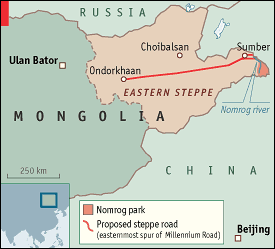
Empires in East Asia
The Mongols, located on the eastern steppe of Eurasia in present-day Mongolia, were rising to power at the decline of the Song Dynasty. In 1200, a Mongol clan leader named Temujin wanted to unify the Mongols under his commands. He fought and defeated all of his rivals one by one. In 1206, Temujin accepted the title of Genghis Khan (universal ruler) of the Mongol clans. His first goal was to conquer China. He invaded the Jin Empire in 1211, but turned his attention to the Islamic region west of Mongolia. Destroying city after city, slaughtering many inhabitants, he finally gained control of most of Central Asia by 1225.
Genghis was a brilliant organizer. He assembled his mongol warriors into mighty fighting forces and grouped his armies into many different groups. He was also a very gifted strategist. Using various attacks, he tried to confuse his enemies. Sometimes a small Mongol cavalry unit would attack, then pretend to flee. The enemy usually gave chase, and that is when the rest of the Mongol army would suddenly appear and surprise the enemy forces. Finally, he used cruelty as a weapon. His beliefs were based on making his enemies so terrified, that they would surrender. If cities refused to open their gates for him, he would kill the whole population when he finally took over.
Sadly, Genghis died in 1227, not from any form of violence, just because he was sick. His successors were able to expand his empire as he wished. In less than 50 years, the Mongols conquered territory from China all the way to Poland. After his death, Khan's sons and grandsons continued the campaign of conquest. They were able to complete their conquest of northern China, invade Korea, leveled the Russian city of Kiev, and reached the banks of the Adriatic Sea. The cities of Venice and Vienna were practically in their grasps. But in the 1250s, the Mongols halted their westward campaign to turn their attention to Persia. By 1260, the Mongols divided their huge empire into four regions, or khanates. There were the Khanate of the Great Khan, the Khanate of Chagatai, the Ilkhanate, and the Khanate of the Golden Horde. Descendants of Genghis ruled each one.
Mongols destroyed the irrigation system in some areas like in the Tigris and Euphrates valleys. Suprisingly, Mongols were quite tolerant in peace. Rarely did they impose their beliefs on any of the people they conquered, and even ended up adopting cultural aspects of their conquered people. Cultural differences led to the decline and eventual splitting up of the empire. From the 1200s to the 1300s, the Mongols imposed a lot of stability into law and order across most of Eurasia. This period was called the Pax Mongolica, or Mongol Peace. Mongols guaranteed safe travels for the trade caravans, travelers, and missionaries from one end of the empire to the other. Unfortunately the Mongol people were the first people to contract the Bubonic plague, and later passed it on to the rest of Eurasia.



